Eugenia Zuroski
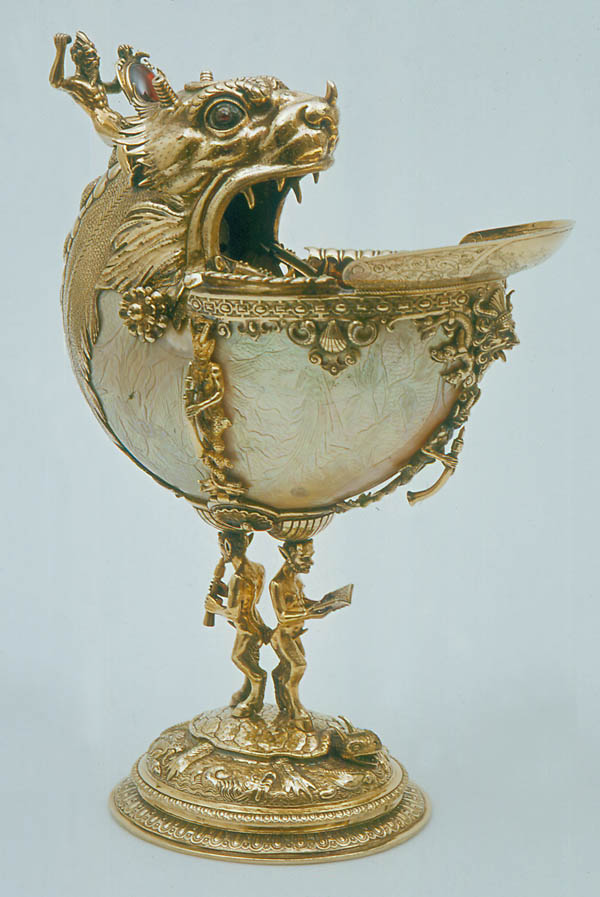
Fig. 1. Nautilus cup, Delft, 1592. Silver-gilt, nautilus shell, glass and enamel, 26.5 x 19.6 x 9.9 cm. Stedelijk Museum het Prinsenhof, Delft. © Image courtesy of the Lewis Walpole Library, Yale University.
In A Description of the Villa… at Strawberry-hill, near Twickenham (1774), the catalogue of his famous collection, Horace Walpole lists among the contents of the Great North Bedchamber “a nautilus mounted in silver gilt, with satyrs and the arms of Paston” that once “belonged to the last earl of Yarmouth.”[1] It is striking, when one has seen the cup, that Walpole would neglect to mention a primary aspect of its design: the enormous cresting head of a toothed sea monster at the top (Fig. 1). More so than other examples of nautilus cups, even those that present the same sea monster motif, this cup confronts the viewer in the form of a creature, fixing and returning one’s gaze with its gleaming red eye. The cup, now housed in the Prinsenhof Museum in Delft, was made in that city in 1592. It is sometimes attributed to the silversmith Nicolaes de Grebber due to a maker’s mark that may be his signature cooking-pot, but the mark is “poorly struck” so this identification remains uncertain.[2] The Paston coat of arms is engraved on the upper surface of the shell and was presumably added around 1660, when Sir Robert Paston, later Earl of Yarmouth, acquired the cup for his collection. Like Walpole after him, Paston documented the cup’s presence in his house as part of a distinguished collection: it is one of a number of shells and shell cups that appear in an anonymous still life from around 1665 that displays, in an unceremonious heap, the Earl’s most prized possessions (Fig. 2).
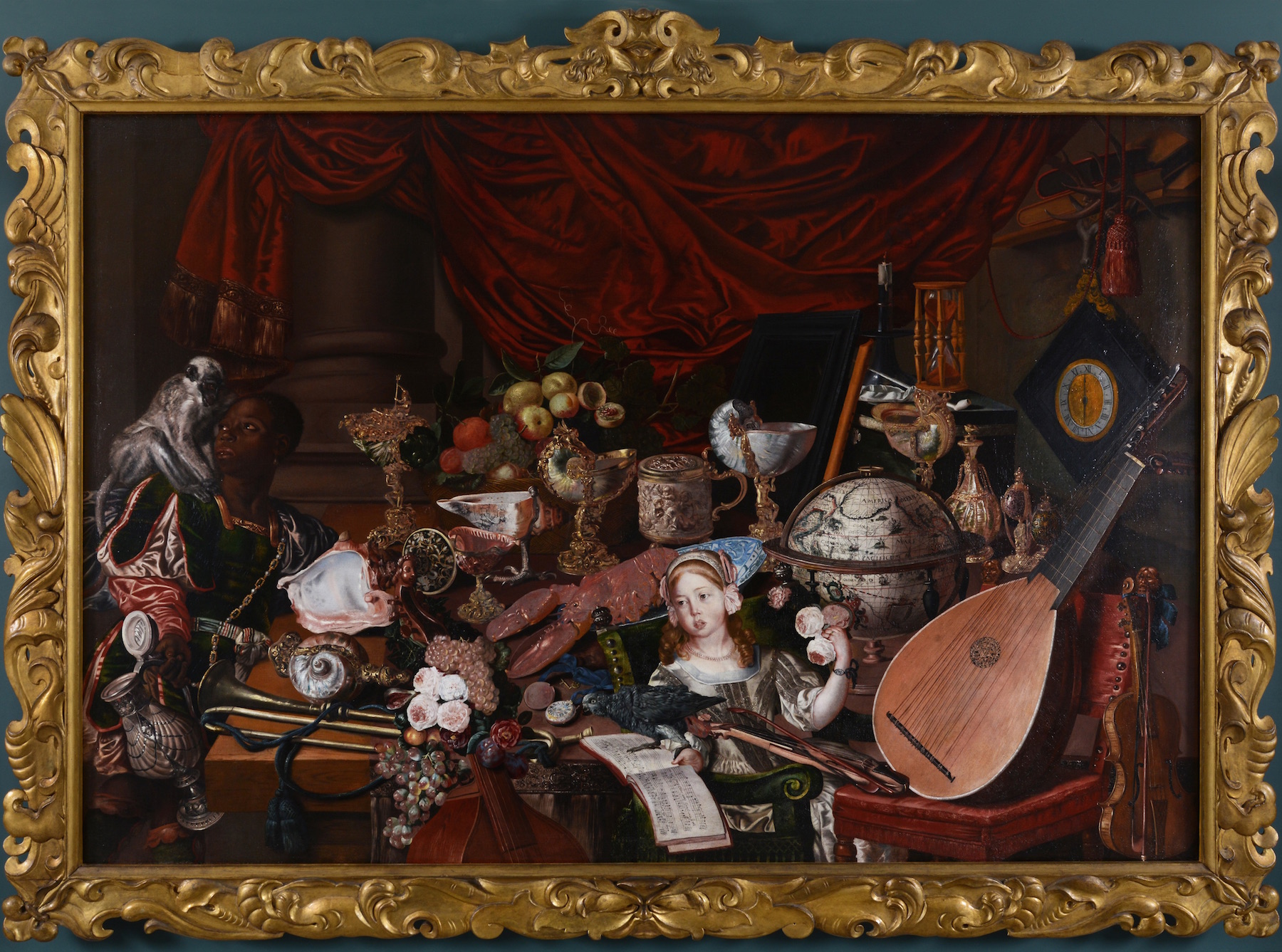
Fig. 2. Anonymous (Dutch School), The Yarmouth Collection, c. 1665. Oil on canvas, 165 x 246.5 cm. Norwich Castle Museum & Art Gallery, Norfolk. © Image courtesy of Norfolk Museums Service.
This cup presents an intriguing instance of the cultural life of curiosities. Nautilus shells were considered prized novelties in Europe at least as early as the thirteenth century,[3] owing partly to the mysterious biological life of the creature that they evoke but do not present. At the same time that these shells frame the conspicuous absence of their original living inhabitants, as they were taken up by human hands and exchanged across global trade networks, they accrued marks testifying to other forms of existence—the mythological lives of gods and monsters, the historical lives of artisans and collectors, and the phenomenological lives of things in human contexts. In this essay, I approach the Prinsenhof nautilus cup less as a historical artifact than as a formal occurrence in order to focus on the semiotics of the cup’s elaborate, hybrid form in its shifting contexts. As the nautilus shell moves into and through human culture, I argue, it serves to locate and organize particular sets of meaning, but in a formally restless way that refuses to settle into firm historical narratives or singular iconic significance. During the long eighteenth century, as nautilus cups migrated representationally into still life paintings and second-generation collections like Walpole’s Strawberry Hill, this restlessness was amplified into a motif: the capacity of a culture’s most meaningful objects to refuse to yield meaning, or to “stop working for us,” in Bill Brown’s formulation of “things.”[4] In so doing, such objects introduce instability into the semiotic structure of our own forms of a meaningful life.
An Empty Shell
The living nautilus tends not to make contact with human beings, so for the vast majority of Western history, the living creature that generates the nautilus shell was understood primarily through imaginative fictions.[5] Fanciful descriptions can be traced as far back as Aristotle, who seems to refer briefly to the chambered nautilus in his Historia animalium as a shelled “polypus” that “never comes out of its shell, but … from time to time protrudes its feelers.”[6] The Renaissance anatomist Pierre Belon is credited with the first modern use of the term “nautilus” to describe the animal;[7] with this designation, he not only conflated several distinct species (including the chambered nautilus and the argonaut or “paper nautilus”) but also reified one of Western culture’s most enduring myths about the creature—that it occupies its shell as a kind of ship and navigates the surface of the ocean with the help of a membrane that it unfurls like a sail.[8] In 1705, the publication of Dutch East India Company employee Georg Everhard Rumphius’s monumental Ambonese Curiosity Cabinet offered European readers detailed (though, according to some contemporary biologists, not particularly accurate[9]) descriptions of the creature based, ostensibly, on the author’s observations of specimens he encountered while living in the Molucca Islands in the second half of the seventeenth century.[10] While, in contrast to Belon, Rumphius was careful to distinguish the chambered nautilus (which he called Nautilus major sive crassus) from the paper nautilus (Nautilus tenuis), he nevertheless referred to the chambered nautilus’s shell as a “boat,” including references to its “keel,” “stern,” and “hold.”[11]
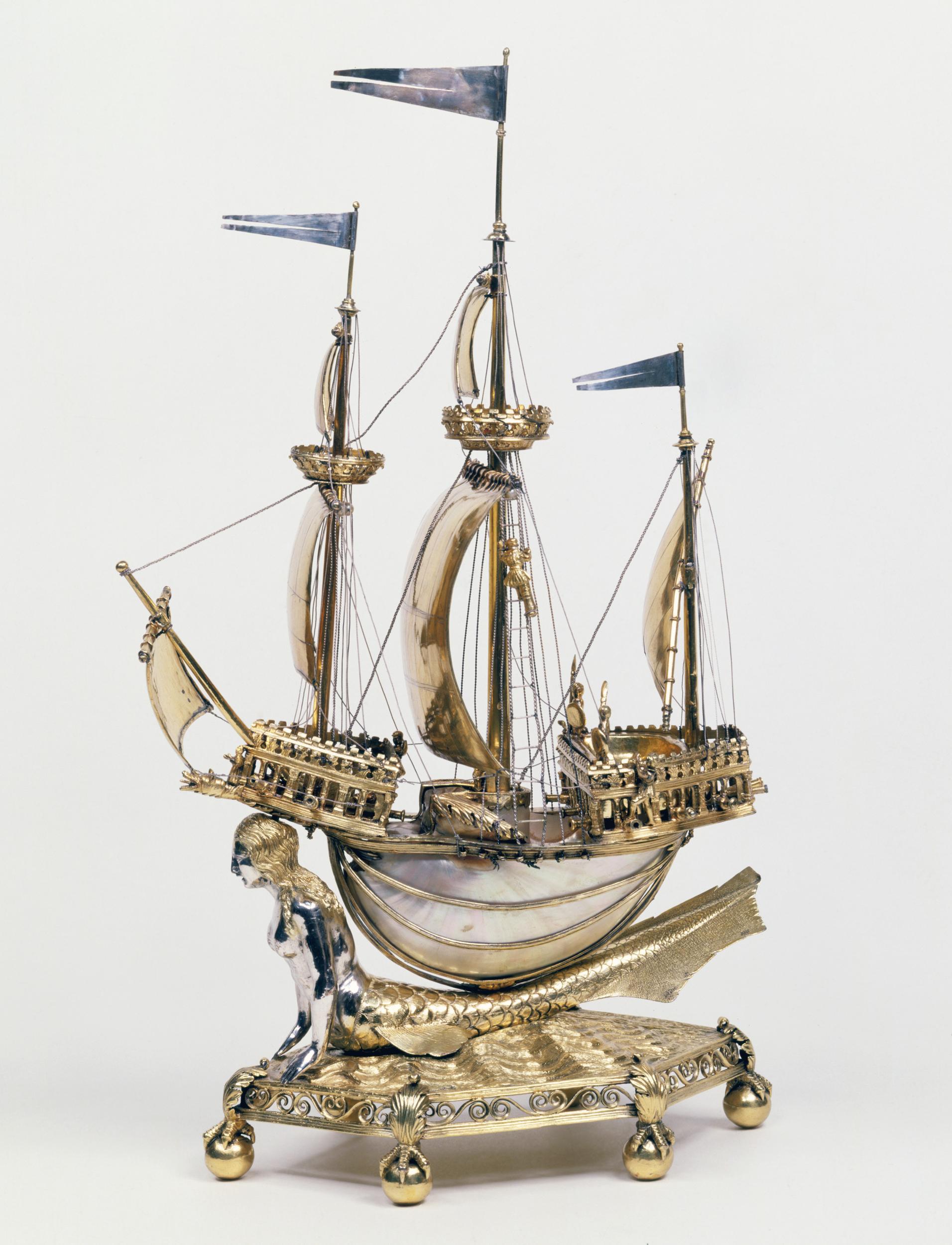
Fig. 3. The Burghley Nef, Paris, 1527-28. Nautilus shell with parcel-gilt silver mounts, raised, chased, engraved and cast, and pearls, 34.8 x 20.8 x 12.2 cm. Victoria and Albert Museum, London. Supported by The Art Fund (Cochrane Trust) and the Goldsmiths’ Company. © Victoria and Albert Museum, London.
While the creature itself largely eluded scrutiny until the nineteenth century, its empty shells made their way into human cultural traffic. The shells were collected from the surface of the ocean, where they float when the animal is dead or in distress, or when the “soft parts” of the creature have decayed or been eaten. Asian artisans developed methods for preparing the shells as art objects, methods that migrated, like the shells themselves, to European workshops. Rumphius’s account of the nautilus includes instructions—presumably based on practices he observed in Ambon—for stripping the shell’s outer membrane to reveal its mother-of-pearl, cutting the walls between its chambers, and carving “all kinds of figures” on its surface.[12] Such decorated shells were shipped to Europe, where gold- and silversmiths mounted them for elite collectors. In Europe, they appeared most prominently in the form of nautilus cups, luxury objects of the sixteenth and seventeenth centuries that presented the shells as vessels set in elaborate mounts of precious metal. While there are examples of nefs that literalize the conceit of the nautilus shell as a ship (Fig. 3), the form of the nautilus cup was not limited to predictable figurations, affording a spectacular proliferation of fantastical creatures and assemblages. The cups frequently surround the shell with various kinds of imagined and mythological motifs related to the sea, in oblique and ironic homage to the absent animal to whom it once belonged.[13]
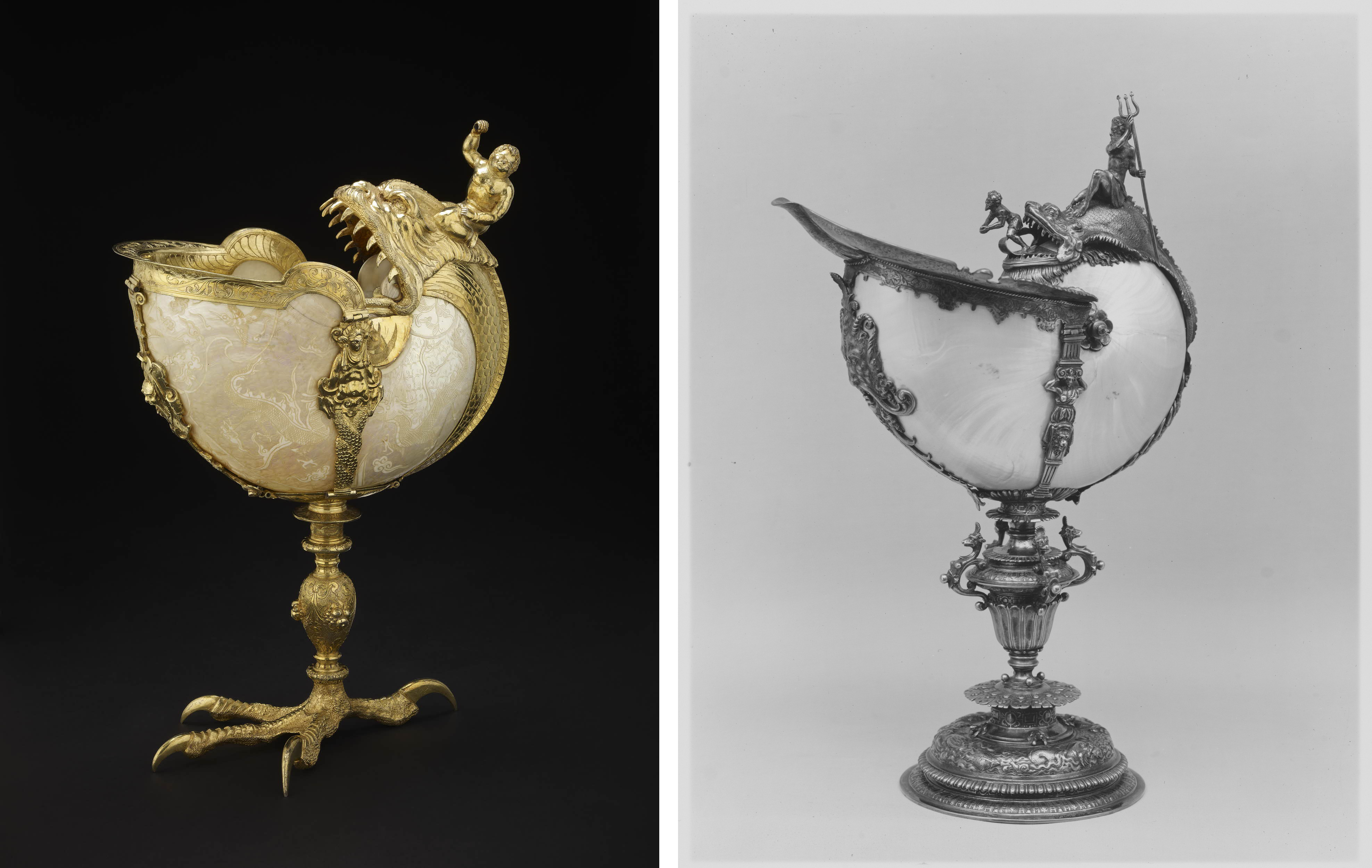
LEFT: Fig. 4. Nautilus cup, Padua (?), mid-16th century. Nautilus shell and silver-gilt, 17 x 26.1 x 10.3 cm. The Waddesdon Bequest at the British Museum, London. © Trustees of the British Museum.
RIGHT: Fig. 5. Nautilus cup, Utrecht, 1602. Nautilus shell and silver-gilt, 27.9 x 16.8 x 10.8 cm. The Metropolitan Museum of Art, New York, USA. © Image courtesy of the Metropolitan Museum of Art www.metmuseum.org.
One subset of nautilus cups pays particular tribute to the marvelous life associated with the ocean: cups, like the one owned by Paston and Walpole, whose design transforms the shells into devouring sea monsters. The Prinsenhof cup presents a particularly “audacious” iteration of this design,[14] of which there are numerous surviving examples from the sixteenth and early seventeenth centuries.[15] One cup, made in or around Padua in the mid-sixteenth century, and now part of the Waddesdon Bequest at the British Museum, resembles the Prinsenhof cup closely in the details of its monster’s gaping mouth, prominent teeth, and pronounced spine and scales running along the outer curve of the shell (Fig. 4). This cup also features a rider posed with a triumphantly raised hand, but whereas the Prinsenhof cup’s rider once held a trident identifying him as Neptune, the Waddesdon cup has been identified as the infant Hercules. Originally, this figure likely held aloft one of the snakes that Hercules famously strangled, emphasizing his mastery over monstrous life.[16] The Metropolitan Museum of Art’s cup from Utrecht, dated 1602, presents Neptune with his trident intact riding a smaller version of the sea monster (Fig. 5). A particularly diminutive example of the monster can be seen in the Milwaukee Art Museum’s late sixteenth-century cup of Flemish or South German origin, in which the creature is not formed out of the shell but perches on top, on a bed of gilt waves that liken the shell not to the body of the animal but to the depths of the ocean itself (Fig. 6).[17]
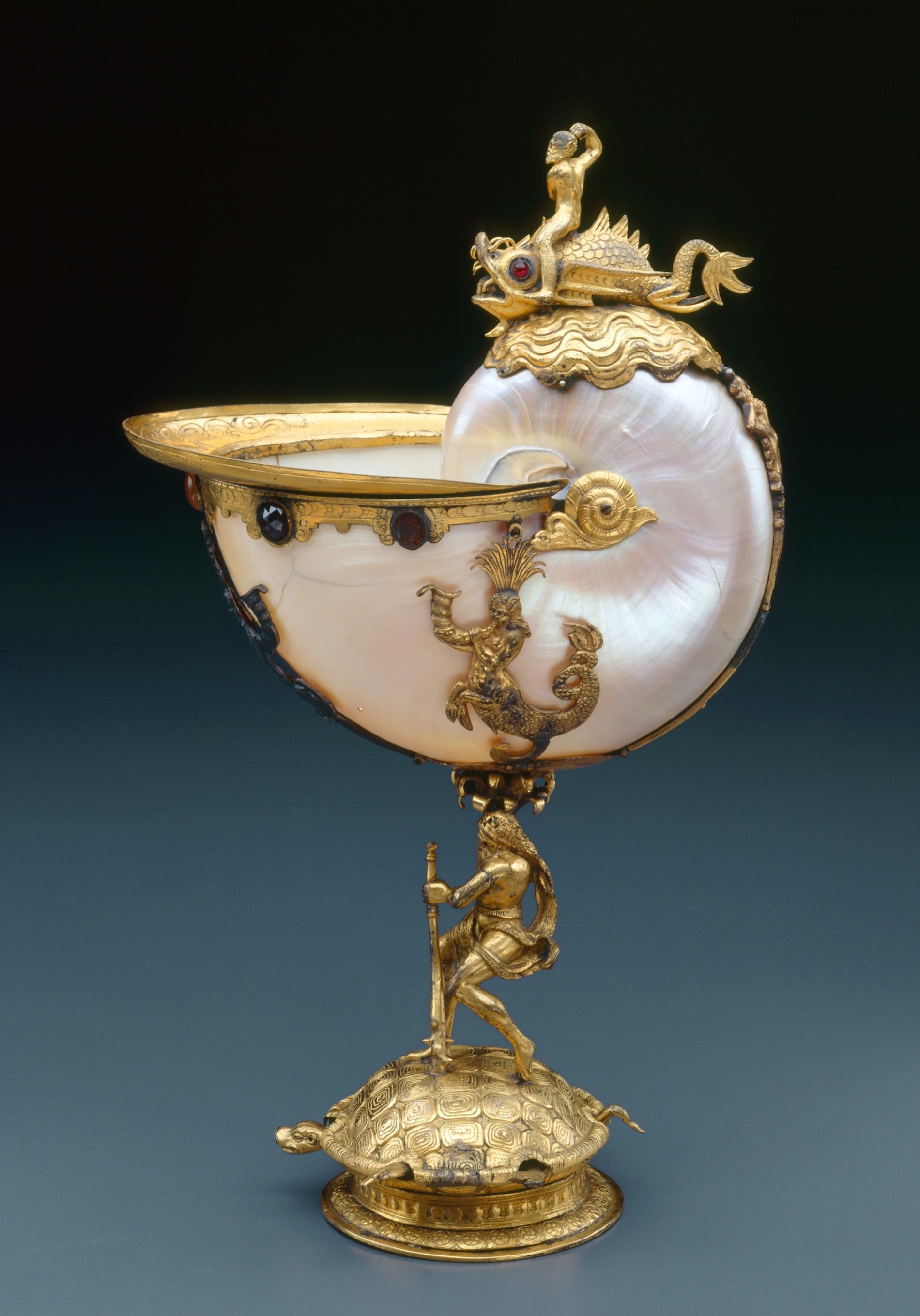
Fig. 6. Nautilus cup, South German or Flemish, 1575/1625. Shell, gilt bronze, copper, silver, and semiprecious gems, 31.75 × 19.05 × 9.53 cm. Milwaukee Art Museum, Purchase with funds from Donald and Donna Baumgartner, M2002.170. © John Nienhuis. Image courtesy of the Milwaukee Art Museum.
As a group, the sea monster cups illuminate the shell’s fluid formal capacity: its ability to represent, simultaneously, a vessel, a creature, and the ocean, and in so doing, to sublimate the dynamics of metamorphosis to the organized appearance of a unified object. The shell is thus presented as a shape-shifter, but a contained and collectable one. Still, the shell’s representational instability is identified as a potential source of trouble by its association with the theme of monstrosity and oceanic peril. The ferocity of the monster is often emphasized by a human figure placed in the path of its open jaws, as seen in the Met cup as well as in a mid-sixteenth-century example from London, now at the Victoria and Albert Museum (Fig. 7). The Met cup, by presenting both the Neptune rider and the fleeing victim, plays explicitly with the design’s ambivalent implications for the viewer. Are we meant to identify with the godlike figure posed serenely in a position of mastery over the object and its various forms of life, or rather with the doomed figure caught between the jaws of the monster and the maw of the shell-as-ocean, who seems to represent human futility in the face of oceanic powers?
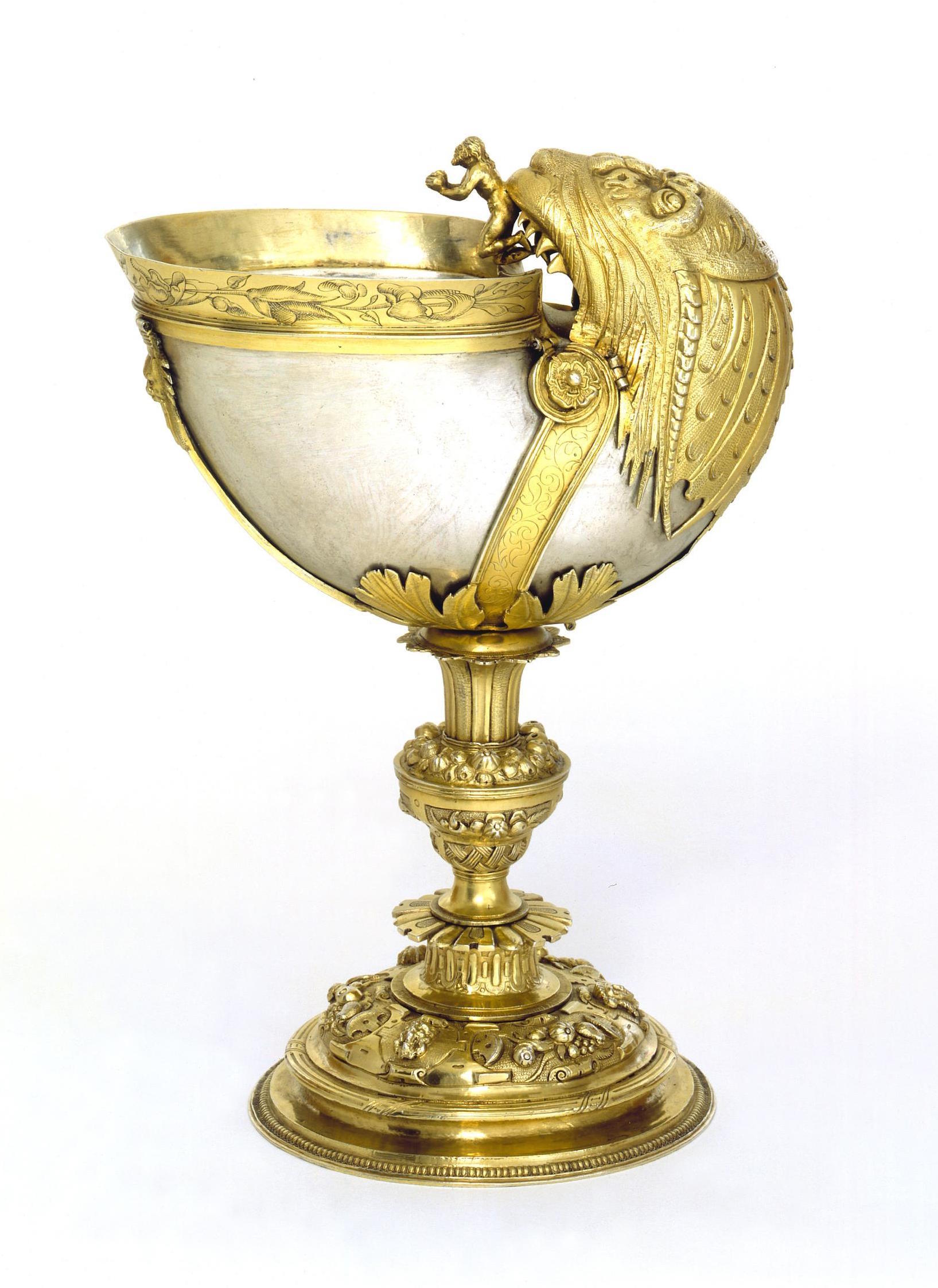
Fig. 7. Affabel Partridge, Nautilus cup, London, 1557-1558/1625-1675. Parcel-gilt silver, the silver shell replacing the original nautilus. Victoria and Albert Museum, London. © Victoria and Albert Museum, London.
Many of the cities in which cups laden with nautical imagery were produced were major ports that channeled the spoils of mercantilist expansion to European collectors and consumers by sea trade. The sea monster motif captures a certain cultural ambivalence lodged in the heart of European nautical ambition. Marsely Kehoe has shown, for example, how the Dutch nautilus cup’s hybrid character formulates a historically distinct iteration of Dutch identity as an emergent global power—an expression of identity at once bombastic and highly unstable.[18] Kehoe argues that the cup comprises heterogeneous components—Dutch metalwork, “Chinese” or “Indian” design,[19] and the organic detritus of an oceanic creature—such that they remain distinct even as they are bound together as a single form, holding in suspense the processes of accumulating, incorporating, and transforming foreign materials as Dutch possessions. The object is made to look like something that is happening, rather than something that simply is: it generates an aesthetic of ambition that points to the present’s energy and the future’s promise. But the traces of that which is not-(yet)-Dutch also introduce a latent form of resistance to the imperial claim by representing that which remains unassimilated in the exercise of Dutch power.
The volatility of this mode of combination is embodied in the Dutch nautilus cup’s recurrent use of grotesque motifs: monstrous faces, mischievous satyrs, clusters of figures depicting the collusion, even the confusion, of animal, human, and godlike forms. As Frances S. Connelly points out, “the one consistent visual attribute of the grotesque is that of flux. Whether aberrant, metaphoric, or combinatory, grotesques are all in a transitional, in-between state of being.”[20] Such motifs enhance the nautilus shell’s innate resemblance to a grotto or cave. While the cups’ spectacular external ornamentation is designed to capture the eye and testify to the skill of the artist, the cup form reminds the viewer that the shell contains an unseen hollow within, and that the object may therefore contain more than meets the eye.[21] Whereas seventeenth- and eighteenth-century still life paintings later wrested the cup’s empty shell as a morbid symbol of vanitas,[22] the Renaissance grotesque tradition presents it differently: as a grottesche space sheltered from recognizable cultural order. In this capacity, the shell serves as a reminder not only of death but also of generation; it becomes “the scene,” in Geoffrey Galt Harpham’s words, “of transformation to and from the realm of the meaningful.”[23]
In almost all of the examples cited above, the mount extends the upward curve of the shell to form the head of a sea monster, such that the bowl of the shell doubles as the gullet of the beast and the body of the ocean. The Prinsenhof cup stands out, however, in its enlargement of the mount, so that the appearance of the shell itself is relatively diminished. Due to the monster’s exaggerated proportions, the ratio of metalwork to shell seems more evenly matched in this cup than in others. Comparatively, it is as if the visual weight of this mount is swallowing the shell before our eyes. This aspect is allegorized by the design—especially without a human figure placed before the monster as a target, the cup shows the monster poised to attempt to swallow the shell itself. While all of the cups that turn the top of the shell into a beast imply the creature’s cresting movement out of and back into the shell’s imaginary depths, the unique size of the creature in the Prinsenhof cup, which is expanded to meet the size of the shell’s lower chamber rather than the upper ones, raises this uncertainty: if the monster were to follow through with its implied movement along the curve’s trajectory, would the shell retake it, or would it consume the shell? Either way, the hybrid creature would consume itself as quickly as it revealed itself. In the arrested form of the cup, the mount and the shell are bound in tense coexistence, held together in formal intimacy by their seeming mutual desire to devour each other.
Combined with the proliferation of grotesque motifs, the cup’s exaggerated monster pushes the bounds of its ability to serve as a stable icon of human nautical power. Even if the cup invites the viewer to identify with the Neptune rider, this relatively diminutive figure recedes as a dominating force not only in comparison to the creature it rides but also among the numerous other mythological creatures incorporated in the mount. Bassoon-playing tritons form the bands of the mount, while two satyrs—each at least as large as the rider, one playing the flute, the other singing from a page—create the stem of the cup. Structurally, this ensemble of figures is much more significant to the formal coherence of the cup than the finial rider, a point emphasized by their being presented as musicians: these supernatural agents are the ones producing the spectacle; this is their field of play. The satyrs, as Reinier J. Baarsen points out, “seem a little out of place in this maritime world,”[24] but they are thematically consistent with the grotesque, in both its emphasis on transformation and its playful rejoinder to human claims of control. Perched atop a giant turtle[25] swimming in fish-filled waters, the satyrs call upon us to recognize the ocean as an unchartable grotesque space: dynamic and unstable, fluidly prolific, animated by various competing forms of nonhuman agency. While the cup ventures, in its rider, to depict the birth of man’s maritime power, it also pays homage to the perilous flux onto which such claims of power are tentatively, precariously staked.
Similarly, as a display of artisanal skill, the form of the nautilus cup has a way of calling into question the very mastery it announces. On the one hand, it demonstrates the artist’s godlike ability to forge objects as complex and wondrous as the universe itself, by calling forth tropes from various cultures around the globe, combining mythologies, and negotiating the marriage of nature and artifice. On the other, it achieves this effect only by drawing upon the grotesque object’s potential to evoke more meaning than the artist, or even culture itself, can control. This is an aesthetic vocabulary situated at the limits of human agency: becoming a master of it paradoxically entails generating forms that refuse or exceed humanism’s master narratives—allegories of imperial greatness, testimonies of artistic accomplishment, accounts of historical progress. Far from confirming causes and effects, origins and destinies, or, generally, what things are supposed to mean in a work of art, the grotesque is a lexicon of spiralling uncertainty that endows material objects with forms of life that overwhelm interpretation. Connelley describes this as the “self-eating character” of grotesque art, which “turns received ideas, normal expectations, and social and artistic conventions against themselves.”[26] The uniquely “self-eating” form of the Prinsenhof cup highlights the nautilus cup’s capacity to unsettle and invert the various cultural and political meanings it is designed to organize.
As oceanic grotto, the Renaissance mounted shell reminds us that it contains invisible depths, capacities beyond representation. By the early eighteenth century, however, European viewers had access to representations of the shells’ interior spaces, and the form of the shell was adapted to rococo and neoclassical aesthetics that abandoned the grotesque’s creaturely quality for more abstract designs. Rumphius’s Ambonese Curiosity Cabinet and Robert Hooke’s Posthumous Works (1705) included drawings of empty cross-sectioned nautilus shells that displayed the logarithmic form of the interior chambers.[27] Rumphius also provided the first known drawing of the nautilus animal, but he presented it removed from the shell, in between drawings of two empty shells, one whole and one cross-sectioned (Fig. 8). His illustration thus preserves the form of the empty shell rather than restoring the creature to it. Later in the century, William Hogarth appropriated the idea of the emptied shell to describe a general technique for translating material bodies into linear forms: “[L]et every object under our consideration, be imagined to have its inward contents scoop’d out so nicely, as to have nothing of it left but a thin shell.”[28] Transforming every material body into a shell of itself was, for Hogarth, precisely a method for eliminating the mysterious, impenetrable spaces that define the grotesque; his hollowed-out figures are all surface, inside and outside collapsed into one perfectly visible form. “The very word, shell,” he writes, “makes us seem to see both surfaces alike.”[29]
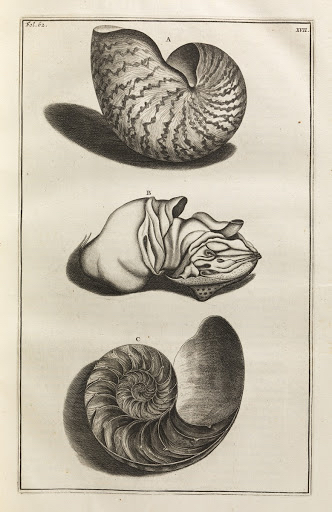
Fig. 8. Chambered Nautilus (Nautilus pompilius) from “D’Amboinsche Rariteitkamer” (The Ambonese Curiosity Cabinet) by Georg Everhard Rumphius, 1705. Page 62, Plate 17. Depicting shell, animal itself, and cross-cut of the shell. From the collection of the Museum Victoria, Carlton, Australia. Source: Google Arts & Culture.
Yet, as evidenced by the Prinsenhof cup’s documented appearance in the Yarmouth and Strawberry Hill collections, the elaborately mounted cups did not disappear, even as the form of the nautilus shell was demystified by Enlightenment-era science and art. In its Renaissance mount, the shell retains a trace of grotesque energy, remaining a container for imaginary monsters. Rumphius’s text presents its own version of this residual fantasy: its one image of an occupied shell is a drawing of a paper nautilus by Wenceslaus Hollar (Fig. 9), itself based on a drawing in Belon’s L’histoire naturelle des estranges poissons marins (1551), that reproduces ancient natural history’s myth of the nautilus as a “sailor.”[30] To imagine the life of the animal that originally inhabited the shell, early eighteenth-century science performs a move similar to the sea monster mounts: it supplies a creature drawn from the vault of cultural fantasy. In the eighteenth-century context, the nautilus shell is thus not only an exotic curiosity but also an uncanny souvenir of the radically exotic life of the nautilus—evidence of a form of life that, having been “scoop’d out so nicely” in the process of acculturation, can only be acknowledged obliquely through convoluted fantasies.
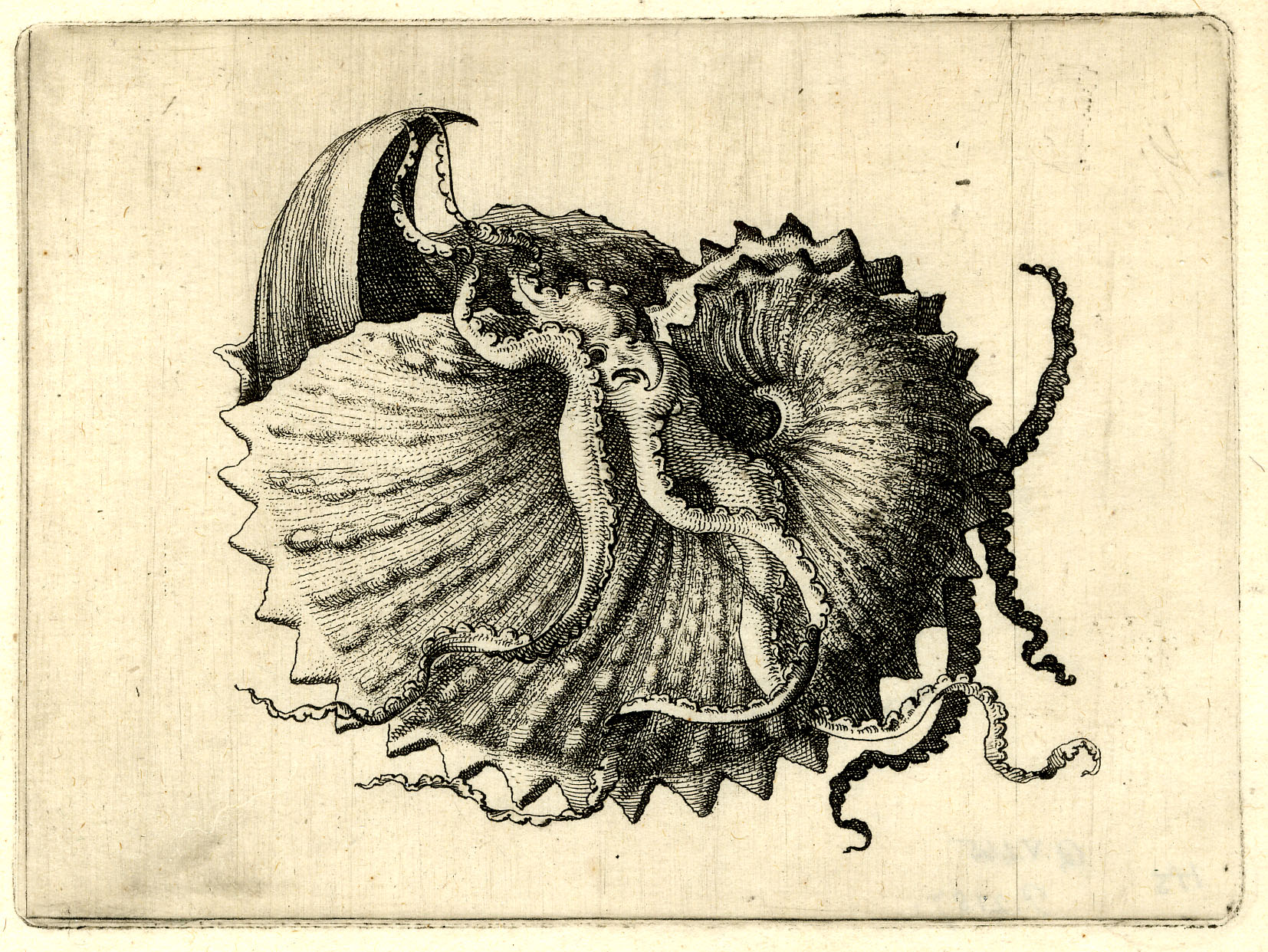
Fig. 9. Wenceslaus Hollar, Nodose paper nautilus (Argonauta nodosa), c. 1646. Etching printed on paper, 98 x 135 mm. British Museum, London. © Trustees of the British Museum.
Unstill Life
Even as archival artifacts, nautilus cups present a distinct challenge to conventional forms of material history. There are no records of where and when particular shells were collected, or of the Asian artisans who stripped and etched the shells before selling them to European craftsmen. While some European engravers and metalworkers, such as the Dutch Bellekin family and the German goldsmith Wenzel Jamnitzer, achieved a certain level of fame for their nautilus works, most attributions for individual cups are either best guesses or acknowledgements of “anonymous masters.”[31] Regional origins are also extremely difficult to establish, not only because the shells and mounts come from different places, but also because of the tendency of the cups’ ornamental motifs to migrate along transnational currents of influence and exchange.[32] Even if a story could be generated for how the object came into being through the combined labors of various human hands, the tale would necessarily begin in medias res if the life of the chambered nautilus were itself taken into account. Before the shell was taken up into culture, an empty vessel seized for art, it housed an animal with a life of its own. The shell is the entire archive of the creature’s life story, its sole trace. That there was a life is undeniable, but we can know nothing more with any certainty.
Nautilus cups are, in other words, unstable carriers of historical information. Despite the busy quality of their design, they preserve no readable information about the animal that generated the shells, of the oceans they moved through, or of their collection from the seas. Despite their status as masterworks of craft, they are manufactured outside a system of art production that attributes objects to the work of a single, identifiable artist’s hand. The Prinsenhof cup, as mentioned above, is sometimes attributed to de Grebber’s workshop, but it is impossible to confirm this provenance due to the ambiguity of the maker’s mark. In nautilus mounts, these marks are frequently missing or, as in this case, illegible. Robert Wenley points out that another nautilus cup represented in The Yarmouth Collection painting (Fig. 2) bears the clue to the collection’s owner—the Paston family arms, etched into the top of the shell’s coil—but that “it may well be that they were never on the actual cup, but painted on in this picture to stamp the whole work as another Paston treasure. Unfortunately this cannot be proved, since the original shell of the cup, now in the Rijksmuseum, has long ago been replaced.”[33] These shells prove slippery canvases: they last both too long, engendering objects that outlive their original purposes and identifying connections, and not long enough, decaying within the forms they have acquired.
While nautilus cups resist yielding recognizable life stories, they remain oddly “lifelike” in aesthetic and even phenomenological ways. Both as objects privileged within the odd semiotic space of early modern curiosity cabinets, and as objects that have migrated out of those spaces, cutting unpredictable and sometimes untraceable paths through material history, nautilus cups present a particular instance of what Jane Bennett calls “vibrant matter.” For Bennett, the assemblage of the collection has its own vibrancy, which is both heightened by and in tension with the “vitality” of the individual material entity: “the capacity of things … not only to impede or block the will and designs of humans but also to act as quasi agents or forces with trajectories, propensities, or tendencies of their own.”[34] Curiosity cabinets deliberately wrangled this wayward energy in things, emphasizing the vitality of an object’s exoticism—its aura of having arrived unexpectedly in the European cabinet from somewhere radically elsewhere—over any assimilating gestures that might deaden the effect of wonder. The mounted nautilus was, in this sense, a model curiosity.
As Susan Stewart argues, the collection is a fundamentally presentist form: it defines things in relation to one another in their shared present at the expense of their separate histories.[35] The early modern curiosity cabinet privileged relations of novelty and diversity to generate a sense of the breadth of the world’s “wonders” through an aesthetic of variety, combination, and assemblage.[36] By combining artificialia and naturalia, nautilus cups exemplified the general principle of the Wunderkammer: to assemble things from all over the world, all orders of material existence, without reconciling them to one another or offering a rationale for their amalgamation. The point of the collection is precisely the present tension of containing vast material diversity within close quarters in the absence of an explanatory framework. In this arrangement, the thrill of wonder becomes heightened by the gratification of possession.
To sustain this effect, the early modern curiosity cabinet had to evoke systems of order precisely to suggest that especially “vibrant” objects threatened to confound or subvert the system. As Martin Kemp observes, “much of the life and sustained fascination of the collections for highly sophisticated viewers lay in the refusal of many of the individual objects to submit docilely to precise categorization.”[37] For Kemp, nautilus cups and other applied art objects that incorporate natural specimens in a way that preserves their original form are the most lively examples. They are, he argues, “‘cultural migrators’ of the most peripatetic kind” that confront the viewer with the curio’s tendency to drift categorically in defiance of cultural rigidity.[38] On the one hand, they appear perfectly at home in curiosity collections, not only contributing to but also epitomizing the cabinet’s display of marvelous diversity. On the other, such objects resonate with the uncanny quality of not being at home anywhere—of belonging properly neither to the order of nature nor to the order of human invention. In this way, they render the space of the collection itself uncanny—the proper place for things that have no proper place in the recognized order of things.[39]
The nautilus cup’s disruption of existing systems of categorization, and its consequent gesture toward nascent, alternative cultural logics, affects another kind of space in which the cups routinely appear: the still life painting. Despite the literal connotations of nature morte, still life painting focuses intensely on the question of “life” or vibrancy in represented objects: it probes the dynamics of collected things in relation to one another, and experiments with how arresting objects in the form of a painted image activates material things in unexpected ways.[40] Departing from readings that explain Dutch still life as, fundamentally, either a celebration or an indictment of material luxury under rising mercantilism, Elizabeth Honig suggests that these paintings focus, rather, on “the mentality of collecting,” exploring the way assembled objects generate associative connections that “do not add up to a single logical and coherent picture of the world nor to a classification system of all the world’s objects,” but instead stake out a flexible cultural space able “to absorb and contain new items.”[41] The still life painting, for Honig, engages primarily with problems of context, and experiments with the semiotic effects of creating “illogical” ones.[42] The genre, she argues, “isolates objects from their prior meanings and uses, and allows for their interplay with one another outside of these contexts”—in other words, it frees them from pre-existing contexts so that they can generate previously inconceivable meanings as part of an individual viewer’s new “cognitive arrangement.”[43] By so promiscuously flattering the cognitive operation of any given viewer, however, regardless of cultural context or type of investment, still life objects paradoxically withhold themselves from being entirely claimed by any particular form of cultural ownership.
The still life is not just an assemblage but an invitation to assemble things according to any number of cultural imperatives. This semiotic excess in the still life object is uniquely highlighted in pronkstillevens, or “ostentatious” still lifes. Adriaen van Utrecht’s Pronkstilleven (1644) is typical of these lavishly full, frequently large-scale tableaux that depict overwhelming quantities of luxury goods in various states of overflow: meat spilling out of pies; fruit cascading over the rims of plates, tumbling out of bowls and baskets; silver platters and porcelain dishes hanging precariously over the edges of tables (Fig. 10). The gigantic lobster at the center of this painting, protruding from the large porcelain dish in which it sits, resonates with the irregularly shaped conch shell to the left, another prominent trace of oceanic life that seems to challenge its man-made mount’s ability to contain it.
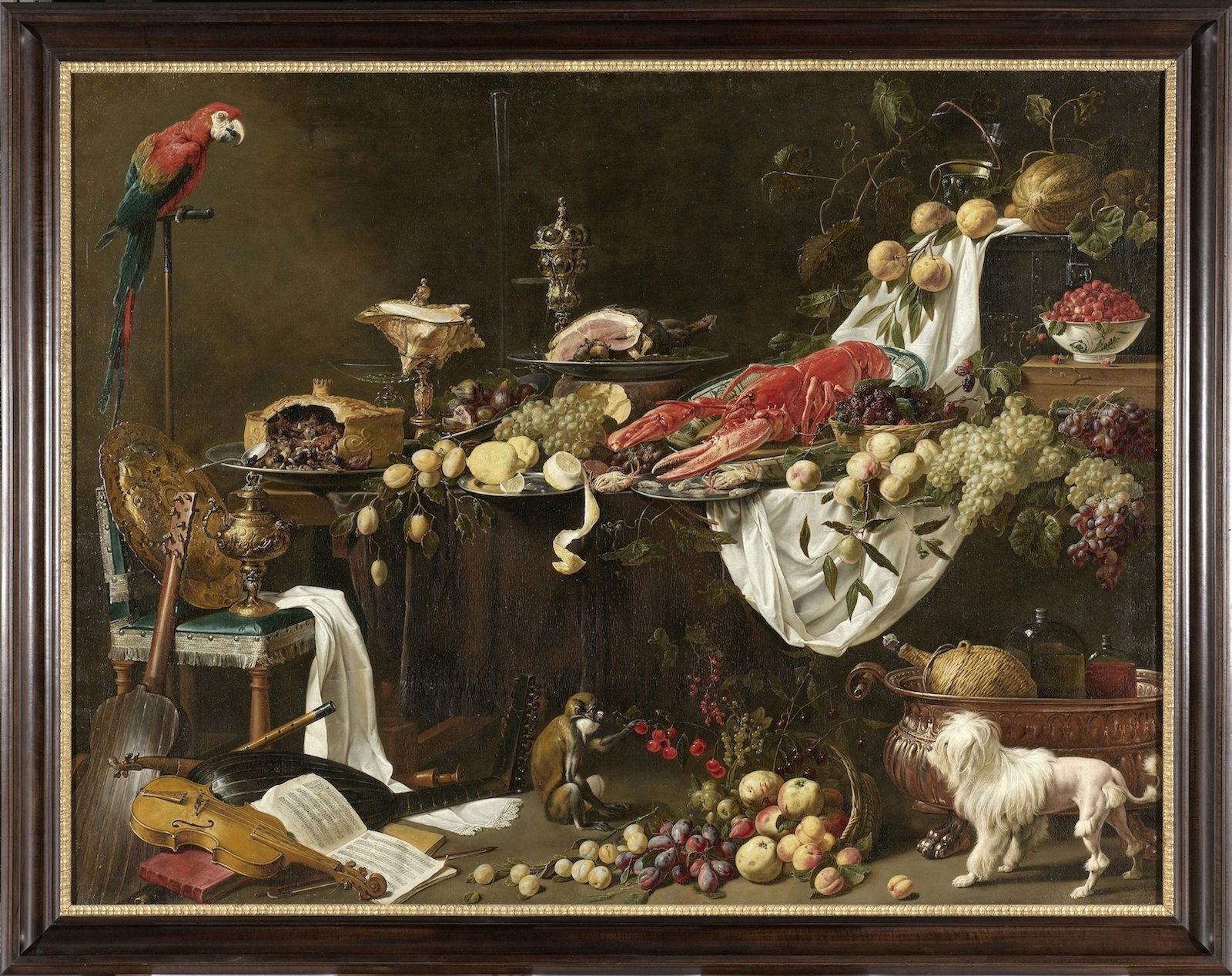
Fig. 10. Adriaen van Utrecht, Pronkstilleven, 1644. Oil on canvas, 185 x 242.5 cm. Rijksmuseum, Amsterdam. © Image courtesy of the Rijksmuseum.
A painting like this one pushes images of wealth and plenty to a point at which they begin to overwhelm the very concept of ownership. Norman Bryson has argued that still life paintings, while they appear on some level to consolidate human possession of things, introduce epistemological instability by deliberately leaving human beings out of the picture: “Human presence is not only expelled physically: still life also expels the values which human presence imposes on the world.”[44] The things that make up the pronkstilleven display are chosen because they signify the heights of human achievement and prosperity. But in their unruly and overflowing arrangement, they confront us with the subversive effect of what Bill Brown calls “thingness”: the capacity of material objects to be more than we can make use of or account for, a startling and confounding quality we encounter in objects “when their flow within the circuits of production and distribution, consumption and exhibition, has been arrested.”[45] Caught on the canvas and left to speak for themselves, pronkstilleven objects present an uncanny glimpse of the thingness in things that resists being reduced to an emblem or prize, to an icon of status or a morsel for human consumption.
Nautilus cups appear recurrently in Dutch pronkstillevens, where they function, as they do in the space of the curiosity cabinet, as ambivalent semiotic compasses. On the one hand, as a Dutch status symbol, the nautilus cup is an icon of prestige that directs us to read all the other objects as versions of the same, down to the painted canvas itself. On the other, the “self-eating character” of the nautilus cup simultaneously consumes its kindred objects in the still life, as well as the painting itself. Bryson discusses the example of Willem Kalf’s Still Life with Nautilus Cup (1662) which both celebrates and “subsumes” the luxury crafts it represents: a china sugar-bowl, a Persian rug, a façon de Venise glass, and a sea monster nautilus cup of similar design and proportions to the Prinsenhof cup, but with the addition of a human victim lunging futilely from the creature’s jaws (Fig. 11). By reproducing the world’s most magnificent artifacts in paint, Bryson argues, Kalf adds “supplementary value” to the precious objects that, paradoxically, instils a sense of lack in the original, which then infects the painted versions as well: “the replica indicates a deficiency in the original object that will not be remedied by the supplement, but contaminates it and so to speak hollows it out.”[46] Kalf’s masterly technique thus “has the unnerving consequence of suggesting a virtuosity that circles endlessly around a kind of void.”[47] The hybrid form of the nautilus cup prefigures these dynamics: the mount is also a supplement that is supposed to enhance the value of the original object, but, by initiating a rivalry with the shell in the process, also enhances the emptiness of the exercise. The cup in the painting allegorizes the futility of ongoing virtuosity in the form of the self-devouring beast chasing itself along the shell’s spiral, around the hollow space that cannot be captured in paint.
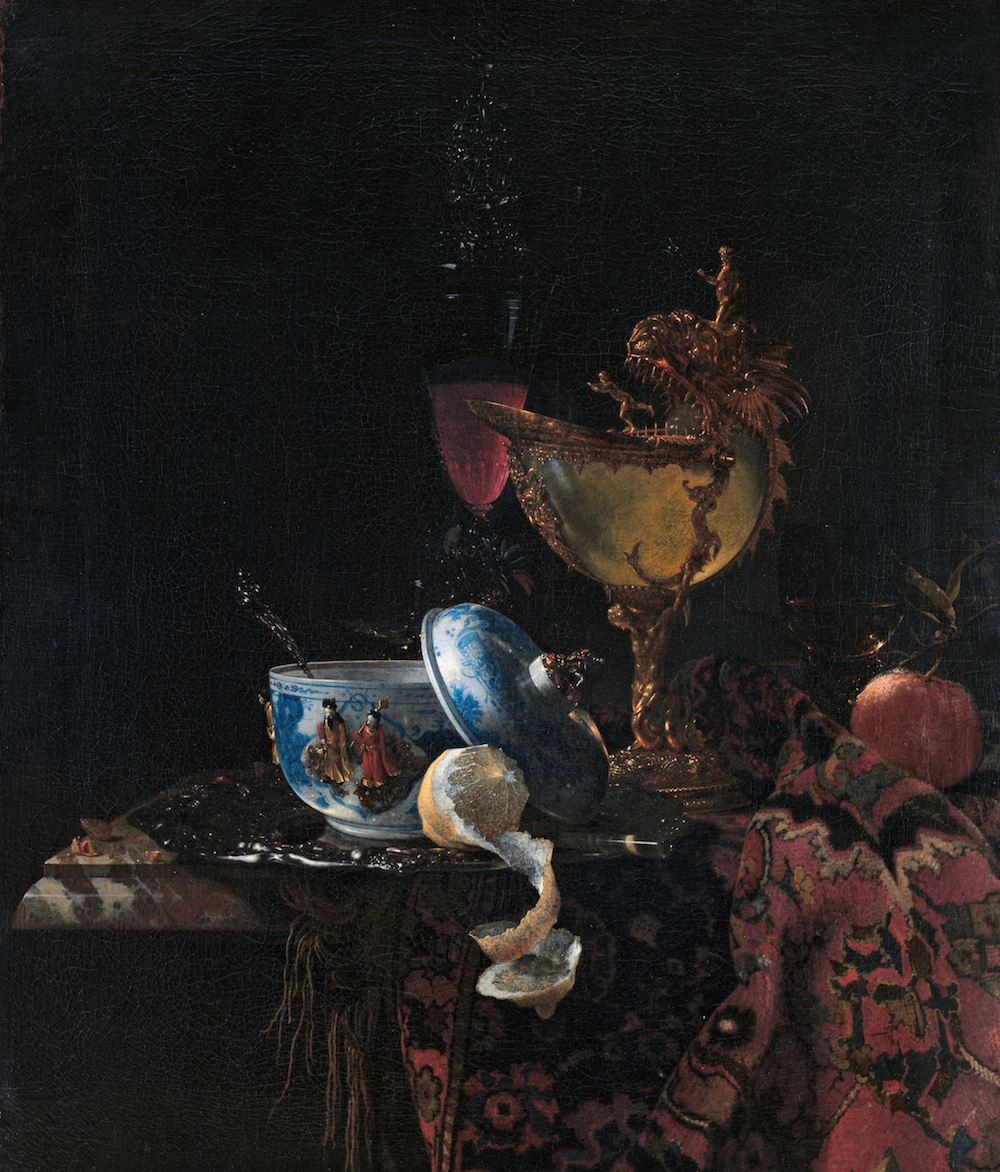
Fig. 11. Willem Kalf, Still Life with Nautilus Cup, 1662. Oil on canvas, 79 x 67 cm. Museo Thyssen-Bornemisza, Madrid. Image source: Wikimedia Commons.
Pronkstillevens and nautilus cups alike thus present a particular version of “thing theory” inspired, or compelled, by Europe’s increased incorporation of luxury goods and curiosities from around the globe. The exotic objects so desired by Renaissance collectors and seventeenth- and eighteenth-century consumers embodied precisely the kind of paradoxical “supplementary value” Bryson describes: their value implies that the European material cultures they have been imported to enrich are fundamentally wanting. Still life paintings and mounted shells confront this problem by experimenting with the ways material excess and reiteration press on and ultimately erode the structures of meaning that give objects value. Both forms worry into action the perversely meaningless qualities of European mercantilist cultures’ most meaningful things.
The odd formal effects of these ostentatious assemblages are in full force in the example of The Yarmouth Collection, the anonymous Restoration-era pronkstilleven depicting the Paston treasures.[48] The painting closely reproduces ornamental detail in individual objects, a technique that was the hallmark of Golden Age Dutch masters like Kalf, but it sets this realism in sharp tension with its distorted representation of three-dimensional space, which flattens the assemblage of objects into something resembling a modern collage. This strange manipulation of space highlights the notion that the space of the painting is “a placeless place,” as Michel Foucault says of the imaginary space of the mirror in which “I see myself there where I am not.”[49] In combination with the faithful depiction of real objects presumably on display in the same house,[50] the flattened space of the painting indeed serves to mirror Paston’s collection, but in a way that enhances the “hollowing-out” effect of overstating, through repetition, a culture’s (or, in this case, a family’s) investment in things. Gathered into the placeless place of the painted image, the Earl’s collected things are framed as having “no place” in their collected state.
By distinguishing itself from the real space of Oxnead Hall, the painted image reflects the material world of the Paston estate in an uncanny form that disturbs the objects’ function as icons of status. A version of the plated lobster from van Utrecht’s painting sits provocatively in the middle of the implausible pile, suggesting that the objects compiled here are not “Paston treasures” at all but have been appropriated by the painting as its own semantic property. They belong now to a recognizable, reproducible set of images that refer reflexively to their own endless capacity for reiteration rather than to the significance of any artist or collector’s name. The painting thus exercises a rival claim to the objects it ostensibly celebrates in the name of the Paston line and estate, implying that its version of these things—an aesthetic vocabulary held in reserve in an unreal space invulnerable to the fluctuations of historical time—will inevitably outlast their historical function as status symbols. It does this by seizing on the collection’s own investment in repeating things excessively, highlighting how such repetitions ironically deplete the collection’s ability to stand emblematically for the Paston name. In addition to performing its own replication of objects, and symbolically replicating the collection as a whole, the painting depicts no fewer than nine mounted shells, pointing to Paston’s penchant for collecting multiple versions of the same kind of precious thing. And while the nine cups in the painting adequately gesture toward the excessive quality of this tendency, they actually represent a small fraction of the number of mounted shells the Earl acquired—an inventory of the collection compiled sometime between 1663 and 1673 lists more than eighty.[51]
Such patterns of ostentatious accumulation have materially depleting effects as well as semiotic ones. By the late 1670s, when Robert Paston was created 1st Earl of Yarmouth, he was heavily in debt. His son and heir, William, compounded these debts after Robert died in 1683, despite auctioning off large portions of the collection. When William died in 1732, the title died with him, and Oxnead Hall was largely demolished in the 1740s.[52] By the time Horace Walpole acquired the nautilus cup bearing the Paston coat of arms, it had become a kind of “living” vanitas object: a material testimony, in its historical drift away from Oxnead and into Strawberry Hill, to the decline of the family that once used it to announce its own prominence. For Walpole, as he notes in his collection’s Description, this is precisely the cup that “belonged to the last earl of Yarmouth.”
Creaturely Haunting
It is easy to imagine that Walpole would have been attracted to the cup’s curious resonance as a newly coined “gothic” relic: an object that distorts time in its commemoration of a lost noble line that is actually, in the eighteenth century, still in the process of dying out.[53] Walpole’s most famous fiction, The Castle of Otranto (1765), codified in the literary form of the “gothic tale” his ongoing fascination with the ways the historical past, an ostensibly lost world, manifests as a thing that is happening in the present—that, in fact, oppresses those living in the present with its mysterious refusal to settle into posterity.[54] The giant helmet that violently crushes the heir to Otranto in the opening pages of the novel is Walpole’s outsized version of the unaccountably lifelike objects of curiosity cabinets and pronkstilleven paintings—objects that, despite their designation as objects of prestige, register through their semiotic restlessness their ontological commitment to some order of existence unconcerned with upholding “human-centred dignity.”[55] The gothic tale is defined by impossibly self-animated objects that stage an unsettling and sometimes violent resistance to living people and their preferred orders of being. By now, this device has attained the status of a cliché, but in the moment Walpole introduces it, it can be seen as a timely descriptive theory of the perplexing, enduring, and alien agency of things seemingly out of place and time.
Since Walpole never wrote about the Prinsenhof cup except to note, in his inventory, its presence in the Great North Bedchamber, it is impossible to know whether this particular object exercised any influence on his imagination when he wrote The Castle of Otranto. Given the prominence of the tale’s enchanted helmet, however, it is worth noting that Dutch nautilus shells also introduce mysterious, disembodied helmets. Rumphius describes the convention of “cut[ting] a small open helmet in the innermost curl” of the nautilus shell, so that when one peers into the chamber of a mounted shell, one is confronted by the sight of a small helm stationed in the shell’s recesses.[56] This method of working the delicate inner chambers of the shell’s curl exploits the native shape of the chamber walls to translate them into the human equivalent of a shell, the familiar form of a suit of armor. The suggestive shape of these fragile walls was likely the impetus for locating this particular design there; it allowed a shell engraver to demonstrate his own meticulous skill symbiotically with the natural design of the organic material. As Hugh Tait notes, carving the helmet entailed the artist’s direct and concentrated engagement with the part of the shell that facilitated the nautilus’s own movement while alive. The design targets
the delicately thin walls of [the] inner chambers of diminishing size, all of which have an interconnecting tube which finally links to the octopus-like creature that inhabits the wide mouth of the shell. Through this tube, the creature controls the gaseous content in the various chambers and thus, it is said, helps to control the rise and fall and general movement of the shell itself within the water.[57]
Walpole’s outlandish gothic fantasy may be a funny way of thinking about nautilus cups, but they share this echoed detail of the unexpected helmet that appears in unrealistic proportions, a harbinger of the fictions, fantasies, and leaps of logic we must be willing to entertain in order to imagine or insist upon points of meaningful contact between human culture and nonhuman life. And in pursuit of this detail, we are led to see the part of the shell where the artist’s hand meets, though in different time, the creature’s own means of autonomous movement. The helmet means nothing, but it marks the site where the thing moves by breathing.
Eugenia Zuroski is Associate Professor of English and Cultural Studies at McMaster University, Ontario, and Editor of Eighteenth-Century Fiction
[1] Horace Walpole, A Description of the Villa… at Strawberry-hill, near Twickenham (Twickenham: Strawberry Hill, 1774), 103.
[2] Ger Luijten et al., eds, Dawn of the Golden Age: Northern Netherlandish Art, 1580–1620, exhib. cat. (Amsterdam: Rijksmuseum with Waanders Publishing, Zwolle, 1993), 428. The description of this cup was written by Reinier J. Baarsen.
[3] Hugh Tait, Catalogue of the Waddesdon Bequest in the British Museum, Vol. 111: The “Curiosities” (London: British Museum Press, 1991), 77.
[4] Bill Brown, “Thing Theory,” Critical Inquiry 28:1 (2001), 4.
[5] The last living example of the nautiloids (the earliest cephalopods in the fossil record, appearing 500 million years ago), the chambered nautilus today lives only in Indo-Pacific waters, normally at depths of several hundred meters. Chambered nautilus is the common name of nautilus pompilious, also known as the pearly nautilus. See Peter Douglas Ward, In Search of Nautilus (New York: Simon & Schuster, 1988); and Richard Arnold Davis, “Nautilus Studies—The First Twenty-Two Centuries,” in Nautilus: The Biology and Paleobiology of a Living Fossil, ed. W. Bruce Saunders and Neil H. Landman (New York: Springer, 2009), 3-21.
[6] Aristotle, and D’Arcy Wentworth Thompson, History of Animals (Raleigh, N.C.: Generic NL Freebook Publisher, n.d.), eBook Collection (EBSCOhost), EBSCOhost (accessed October 31, 2016), 106.
[7] Davis, “Nautilus Studies,” 5.
[8] “Il laisse un espace vuide, sachant que sa coquille en sera plus legiere, a fin que mettant hors & estendant une membrane ou pellicule qu’il ha, & d’icelle faisant voile, laquelle il renforce avec deux de ses iambes ou cirres, l’une deça l’autre dela, il ait le plaisir qu’il pretent estant poulsé legierement du vent par dessus l’eau.” Pierre Belon, L’histoire naturelle des estranges poissons marins (Paris, 1551), 53. On the reproduction of images and descriptions of the nautilus’s “sail,” see Karin Leonhard and Maria-Theresia Leuker, “Who commissioned Hollar’s shells?,” Simiolus: Netherlands Quarterly for the History of Art 37:3/4 (2013–14), 227-239. While the paper nautilus does live close to the surface, the chambered nautilus prefers deeper waters, and typically only comes to the surface when dying or in distress.
[9] “Rumpf’s treatment of Nautilus does not indicate that he studied the animal extensively… [nor] does it appear that he spent much time, if any, observing live animals.” Davis, “Nautilus Studies,” 7. For a more laudatory account of Rumphius’s contribution, see Peter Dance, Shell Collecting: An Illustrated History (London: Faber and Faber, 1966), 46-50. Rumphius, according to Dance, “must be considered the pioneer and for long the chief exponent” of the field of molluscan ecology. Dance, Shell Collecting, 49.
[10] Georg Everhard Rumphius, The Ambonese Curiosity Cabinet, trans. E. M. Beekman (New Haven and London: Yale University Press, 1999). Like most of Rumphius’s works, this book was published posthumously; he died in Ambon in 1702. It is difficult to say with any certainty how much of the text’s descriptions are based on the author’s own first-hand observations; Rumphius lost his sight in 1670 and relied on assistants to complete his texts. See Maria-Theresia Leuker, “Knowledge Transfer and Cultural Appropriation: Georg Everhard Rumphius’s ‘D’amboinsche rariteitkamer,” in The Dutch Trading Companies as Knowledge Networks, ed. Siegfried Huigen, Jan L. de Jong, and Elmer Kolfin (Leiden and Boston: Brill, 2010), 145-168.
[11] Rumphius, Ambonese Curiosity Cabinet, 88.
[12] Rumphius, Ambonese Curiosity Cabinet, 90.
[13] I have not seen any examples of nautilus mounts that recreate some version of the nautilus itself. The example that comes closest to representing a creature akin to the nautilus is a cup held in the Fitzwilliam Museum, Cambridge, made in London, c. 1585-1586, that depicts a lobster embracing the upper curl of the shell. http://webapps.fitzmuseum.cam.ac.uk/explorer/index.php?oid=118322 (accessed 13 February 2017).
[14] Ger Luijten et al., eds, Dawn of the Golden Age, 427.
[15] Carl Hernmarck identifies Delft workshops as the source for “mountings in the shape of a large gaping sea monster” and Rotterdam as the source for mountings featuring a rider-bearing dolphin attached as a finial. Reinier J. Baarsen, however, identifies the Delft cup’s design as “a direct derivative of sixteenth-century Antwerp prototypes.” See Hernmarck, The Art of the European Silversmith, 1430-1830 (London and New York: Sotheby Parke Bernet, 1997), 1:113; and Ger Luijten et al., eds, Dawn of the Golden Age, 427.
[16] See Tait, Waddesdon Bequest, 68.
[17] This is an example of the design Hernmarck identifies with Rotterdam workshops. An example made in Rotterdam in 1589 is held in the Museum Boijmans van Beuningen in Rotterdam: http://collectie.boijmans.nl/en/object/89026/nautilus-cup/Onbekend (accessed 13 February 2017).
[18] Marsely Kehoe, “The Nautilus Cup between Foreign and Domestic in the Dutch Golden Age,” Dutch Crossing 35:3 (2011): 275-285.
[19] The cups’ exotic references are themselves unstable—deliberate, yet materially indeterminate. The Waddesdon Bequest cup offers a particularly good example of this ambivalence. Its elaborately carved shell presents clearly recognizable chinoiserie motifs including dragons, birds, and flowers, but these motifs cannot be traced to any particular region or workshop within China. In fact, such designs were an efficient way of reproducing a “Chinese” aesthetic globally, detaching ornament from a site of origin. According to Tait, “it seems… that various unidentified Chinese workshops were producing these carved nautilus shells by the third quarter of the sixteenth century,” but “as nothing has yet been established about the location of the workshops … the standard modern description of these early nautilus-shell carvings as being ‘of Chinese origin’ is little more than a convenient solution by which to acknowledge the distinctly Chinese character of the decorative motifs. Precisely where or by whom they were carved is still unknown.” Tait, Waddesdon Bequest, 82-84.
[20] Frances Connelly, The Grotesque in Western Art and Culture: The Image at Play (Cambridge and New York: Cambridge University Press, 2014), 5.
[21] Kehoe points out that, in contrast to the varied shapes of German mounts, “nearly every Dutch shell was mounted in the form of a goblet,” a form that is significant both for “its potential to hold liquid,” symbolizing Dutch mastery of the ocean, and for how “the shell is celebrated, rather than subverted” by the design. Dutch mounts, in other words, are designed to make it impossible for a viewer to overlook the native qualities of the shell itself, including its unseen interior chambers. Kehoe, “The Nautilus Cup,” 277.
[22] See, for example, Pieter Claesz’s Vanitas Still Life with Nautilus Cup (1634), held at the LWL-Museum for Art and Culture, Münster, Germany. http://beta.artothek.de/de/bild-details/19182.html (accessed 3 March 2017).
[23] Geoffrey Galt Harpham, On the Grotesque: Strategies of Contradiction in Art and Literature (Princeton: Princeton University Press, 1982), 40.
[24] Ger Luijten et al., eds, Dawn of the Golden Age, 428.
[25] The mytheme of the “world turtle” or the “world-bearing turtle” appears in multiple cultural traditions including Indian, Chinese, and indigenous North American, and was recorded by Europeans since the seventeenth century. See Jay Miller, “Why the World Is on the Back of a Turtle,” Man 9:2 (1974): 306-308.
[26] Connelley, The Grotesque in Western Art and Culture, 11.
[27] See Kehoe, “The Nautilus Cup,” 282; and Sachiko Kusakawa, “Drawings of Fossils by Robert Hooke and Richard Waller,” Notes and Records of the Royal Society 67 (2013): 123-138, http://rsnr.royalsocietypublishing.org/content/67/2/123 (accessed 1 March 2017).
[28] William Hogarth, The Analysis of Beauty (London, 1753), 7.
[29] Hogarth, The Analysis of Beauty, 7.
[30] See Leonhard and Leuker, “Who commissioned Hollar’s shells?,” 228–231. A particularly fanciful example of this “sailing” nautilus can be found in the Nautilus Emblem, No. 49, in Joachim Camerarius’s Symbolorum et emblematum ex aquatilibus et reptilibus (Nuremburg, 1604). http://fondosdigitales.us.es/media/books/682/682_221695_106.jpeg (accessed 2 March 2017).
[31] See, for example, J. W. Frederiks, Dutch Silver: Embossed Ecclesiastical and Secular Plate from the Renaissance until the End of the Eighteenth Century (The Hague: Martinus Nijhoff, 1961).
[32] On the difficulty of determining the provenance of nautilus mounts in the Northern Italian context, see Tait, Waddesdon Bequest, 72-79.
[33] Robert Wenley, “Robert Paston and The Yarmouth Collection,” Norfolk Archaeology 41: 2 (1991), 118. There are four nautilus cups in the painting, as well as several other mounted shells. The Paston arms engraved in the Prinsenhof shell are not visible in the painting, as the cup is turned away from the viewer.
[34] Jane Bennett, Vibrant Matter: A Political Ecology of Things (Durham and London: Duke University Press, 2010), viii. Bennett, drawing on Deleuze and Guattari, defines assemblages as “ad hoc groupings of diverse elements, of vibrant materials of all sorts. Assemblages are living, throbbing confederations that are able to function despite the persistence of energies that confound them from within.” Bennett, 23-24.
[35] Susan Stewart, On Longing: Narratives of the Miniature, the Gigantic, the Souvenir, the Collection (Durham and London: Duke University Press, 1993), 152.
[36] See Lorraine Daston and Katharine Park, Wonders and the Order of Nature, 1150–1750 (New York: Zone Books, 2001), 255-301; Patrick Mauriès, Cabinets of Curiosities (London: Thames & Hudson, 2002), 69-127; Joy Kenseth, “A World of Wonders in One Closet Shut,” in The Age of the Marvelous, ed. Joy Kenseth (Hanover, NH: Hood Museum of Art, 1991), 81-101; and Martin Kemp, “‘Wrought by No Artist’s Hand’: The Natural, the Artificial, the Exotic, and the Scientific in Some Artifacts from the Renaissance,” in Reframing the Renaissance, ed. Claire Farago (New Haven: Yale University Press, 1995), 177-196.
[37] Kemp, “‘Wrought by No Artist’s Hand,’” 185.
[38] Kemp, “‘Wrought by No Artist’s Hand,’” 179.
[39] Along these lines, Maria-Theresia Leuker has argued that the curiosity cabinet operates like a Foucaultian heterotopia, or, borrowing from Bruno Latour, “a repository for ‘immutable and combinable mobiles.’” Leuker, “Knowledge Transfer and Cultural Appropriation,” 162. Latour is quoted from Science in Action: How to Follow Scientists and Engineers through Society (Cambridge, MA: Harvard University Press, 1987), 227. On heterotopias, see Michel Foucault, “Of Other Spaces,” trans. Jay Miskowiec, Diacritics 16:1 (1986): 22-27.
[40] As Svetlana Alpers says of Willem Kalf’s lemons, “We have never seen a lemon in this way before.” Alpers, The Art of Describing: Dutch Art in the Seventeenth Century (Chicago: University of Chicago Press, 1983), 91.
[41] Elizabeth Alice Honig, “Making Sense of Things: On the Motives of Dutch Still Life,” RES: Anthropology and Aesthetics 34 (1998), 176, 179.
[42] Honig, “Making Sense of Things,” 179-183.
[43] Honig, “Making Sense of Things,” 183. For an elaboration of this idea, see Sean Silver, The Mind Is a Collection: Case Studies in Eighteenth-Century Thought (Philadelphia: University of Pennsylvania Press, 2015), esp. 1-20. James Bunn, focusing on British collections of the seventeenth and eighteenth centuries, emphasizes the way the open logic of the collection lends itself to imperialism. James Bunn, “The Aesthetics of British Mercantilism,” New Literary History 11:2 (1980), 303-321.
[44] Norman Bryson, Looking at the Overlooked: Four Essays on Still Life Painting (London: Reaktion Books, 1990), 60.
[45] Brown, “Thing Theory,” 4. Brown adopts the concept of “thingness” from Martin Heidegger. See Martin Heidegger, Poetry, Language, Thought, trans. Albert Hofstadter (New York: Harper & Row, 1971), especially “The Origin of the Work of Art,” 17-86, and “The Thing,” 163-184.
[46] Bryson, Looking at the Overlooked, 126.
[47] Bryson, Looking at the Overlooked, 126.
[48] According to Robert Wenley, while “stylistically it belongs to the Dutch or Flemish school,” The Yarmouth Collection “was almost certainly painted in England, during the reign of Charles II.” Wenley, “The Paston Treasures: Portrait of a Seventeenth-Century Collection,” Silver Studies 19 (2005), 131.
[49] Foucault, “Of Other Spaces,” 24.
[50] Honig points out that this is, to the best of her knowledge, the only painting that portrays “an actually extant object collection.” Honig, “Making Sense of Things,” 177 n26. Robert Wenley has identified many of the extant objects that appear in the painting. See Wenley, “The Paston Treasures,” 131-136; and “Robert Paston and The Yarmouth Collection,” 113-128.
[51] Wenley, “The Yarmouth Collection,” 118-120.
[52] Wenley, “The Paston Treasures,” 131.
[53] According to Wenley, the Paston family “died out in the early nineteenth century.” Wenley, “The Paston Treasures,” 131.
[54] Horace Walpole, The Castle of Otranto (London, 1765). See Ruth Mack, “Horace Walpole and the Objects of Literary History,” ELH 75:2 (2008), 367-387. Mack reads Otranto as a theoretical investigation into the way material objects allow us to “access” history, one that demonstrates a certain level of magical thinking in the conventions of material historiography that believes the past arrives into the present in the form of material things. “Objects,” she writes, “if we think of them as embodying the past, stand to promote an understanding of that past that, because it is undifferentiated from the present, isn’t historical at all.” Mack, “Horace Walpole,” 377.
[55] Bryson, Looking at the Overlooked, 60.
[56] Rumphius, Ambonese Curiosity Cabinet, 90. Tait points out that most attributable surviving examples of shells with this open helm design can be traced to Dutch workshops. Tait, Waddesdon Bequest, 99-100. I have not had the opportunity to confirm whether or not the Prinsenhof cup contains a helmet carving.
[57] Tait, Waddesdon Bequest, 99.
Cite this article as: Eugenia Zuroski, “Nautilus Cups and Unstill Life,” Journal18, Issue 3 Lifelike (Spring 2017), https://www.journal18.org/1493. DOI: 10.30610/3.2017.3
Licence: CC BY-NC
Journal18 is published under a Creative Commons CC BY-NC International 4.0 license. Use of any content published in Journal18 must be for non-commercial purposes and appropriate credit must be given to the author of the content. Details for appropriate citation appear above.
